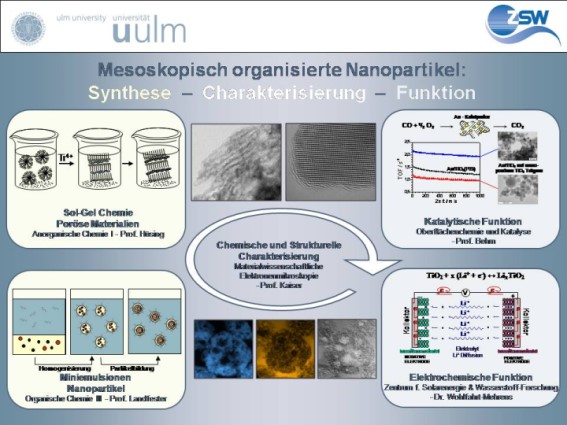|
|
 |
 |
|
|
Nanostructured, Mesoporous Au/MeOx Catalysts for Low Temperature Oxidation and Reduction
Prof. Dr. Jürgen Behm
University of Ulm
Institute of Surface Chemistry
And Catalysis
(Physical Chemistry II)
Ulm
The project aims to assess the possibilities of a novel synthesis approach for monodispersive, mesoporous AuMeOx nanoparticles for applications in heterogeneous catalysis, in particular for oxidation and reduction reactions at low temperatures in terms of a molecular understanding of the processes. The synthesis process has considerable potential based on the following:
I.The resulting catalysts promise a high dispersion and high activity due to their mesoporous structure and the distribution of the active metal species within the particle.
II.The anchoring in the pores enables a stabilisation of the active metal particle.
III.The easy formation of mixed oxide carriers by altering the carrier acidity offers the possibility to control the formation of by-products.
IV.The homogeneous diffusion properties of the individual composite particles result in new possibilities to control the catalytic reactions by utilizing transport effects.
In this project the nanostructured AuMeOX composite particles (precatalysts) synthesised by the project partners will be transferred to an active state by suitable processing (conditioning) and in particular by removing the organic elements. Subsequently, the chemical and catalytic properties of the resulting catalysts as well as the dependence of these properties on the morphology/structure and on the chemical state of the AuMeOx particles will be determined by spectroscopic (XPS, IR), electron microscopic (TEM) and kinetic/mechanistic investigation of reactions. Transport and diffusion effects will be registered on a TAP reactor by means of rapid time-resolved measurements. The research is directed towards a molecular understanding of the processes during conditioning and the catalytic reaction, providing a basis for the specific optimisation of these nanostructured materials and their synthesis conditioning process. With suitable catalysts these findings are to be complemented by relevant aspects, such as catalytic and transport behaviour under realistic conditions etc.
|
|
 |
 |
|
|
Structured Nanomaterials Derived from Nanocompartments
Prof. Dr. Katharina Landfester
University of Ulm
Institute of Organic Chemistry III
(Macromolecular Chemistry &
Organic Materials)
Ulm
The aim of this project is to manufacture multi-functional inorganic particles by combining sol-gel processes and miniemulsion techniques. This combination should exhibit a unique property profile: a tailor-made hierarchic nanoscaled assembly with a monodispersive size distribution of the particles adjustable from 20 to 500 nm and an internal nanostructure with a periodic recurrence within the range of 2–10 nm. By charging the nanoparticles with Au/MeOx, they can be applied in heterogeneous catalysis, especially for oxidation and reduction reactions at low temperatures. The synthesis process has considerable potential based on the following:
I.The resulting catalysts promise a high dispersion and high activity due to their mesoporous structure and the distribution of the active metal species within the particle.
II.The anchoring in the pores enables a stabilisation of the active metal particle.
III.The easy formation of mixed oxide carriers by altering the carrier acidity offers the possibility to control the formation of by-products.
IV.The homogeneous diffusion properties of the individual composite particles result in new possibilities to control the catalytic reactions by utilizing transport effects.
The main focus of this project is on the production of novel structured inorganic nanoparticles in the presence of various interacting surfactant molecules. Surfactant molecules will be applied as a structure-directing agent in the drops of the precursor components and in order to guarantee the stability of the nanodrops in the continuous phase. The condensation reaction produces particles which can be charged with catalytic active substances.
|
|
 |
|
|
 |
 |
 |
|
|
High-resolution Analytical Transmission Electron Microscopy for the Clarification of the Manufacturing Structure/Property Correlation of Nanoporous Inorganic Materials
Prof. Dr. Ute Kaiser
University of Ulm
Electron Microscopy Group of
Materials Science
Ulm
This project aims at applying modern and conventional methods of transmission electron microscopy (TEM) for the analysis of the structure, morphology, element distribution and size distribution of nonporous inorganic materials. Therefore, the project constitutes an important link in clarifying the correlation between synthesis parameters and the property of the materials. In particular, the subprojects will contribute to the clarification of the following:
(i.) the growth and structure of crystalline mesoprorous monodispersive nanoparticles (subjprojects Hüsing and Landfester)
(ii)the catalytic properties of mesoporous Au/MeOx particles (subproject Behm).
For questions raised in the subproject by Hüsing and Landfester, emphasis will be essentially placed on the illustration of 2D and 3D pore systems. In this new project phase methodical focus will be on electron tomography, even at an accelerator voltage of 80kV. An extensive statistically significant data record, necessary for a reliable statistical nanoparticle analysis, will be provided on the basis of conventional TEM images randomly paired with investigations in high-resolution Zcontrast (STEM). This data is essential to the understanding of heterogeneous catalysis in the subproject by Behm.
The implementation and acceptance of the device parameter of the novel image corrected TITAN 80-300 in the 1st project phase will provide us with excellent technical equipment necessary to apply the various models mentioned above.
|
|
|




